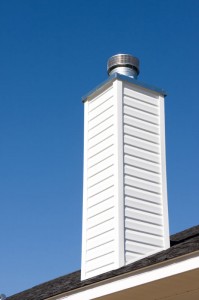Your fireplace is the focal point of family gatherings and a great way to take the chill off during the coldest winter nights. For many, it is a basic necessity. This does cause us to wonder: How can a family love their fireplace but at the same time neglect their chimney system? Sadly, this is an all-too-common occurrence. Your chimney, just like your vehicle, requires regularly scheduled maintenance.
Chimney fires can lead to house fires…
Your chimney system can be a source of real danger to your home and family if neglected. A fireplace that is improperly cared for may start a fire where you don’t want one, namely inside your chimney. Although you remove them often, ashes indicate energy efficiency, showing that the fire completely consumed the fuel source. It’s what doesn’t turn into ash that puts your home at risk. Creosote is nothing more than unburned wood energy that builds up on your chimney’s inner surface.
According to the NFPA, the second leading cause of house fires is heating equipment, and two out of three heating equipment fires result from heating appliances, which includes fireplaces, chimneys and wood stoves. Of the fires that start in the chimney or fireplace, most are a direct result of creosote deposits. Sadly, most are preventable with regular inspections and maintenance. Prevent your home from becoming part of these statistics by scheduling routine chimney inspections to catch dangerous creosote before it catches you.
Keep a watchful eye on your chimney…
Regular chimney sweepings will remove the inevitable creosote and soot deposits that result from the combustion process. The minimum inspection of your chimney system should be yearly. Sweep your chimney when it needs it or when soot or creosote deposits are 1/8th inch or greater. You’ll never be able to keep your chimney 100% creosote-free, but if allowed to sit, creosote will eventually harden into a stubborn glaze that’s next to impossible to remove without special treatments and tools. Creosote is an acid and deteriorates your chimney.
Obviously, if you notice smoke flooding into your house, soot covering your furniture, or even dark smoke back flowing from your chimney and into your living space, you should suspect creosote issues. Unfortunately, creosote may not make its presence so readily known. Until you know how much creosote your burning schedule creates, check your chimney regularly to monitor the accumulation so you can catch it before it gets out of hand.
Please don’t neglect your chimney system maintenance. Inspecting your chimney is critical to ensuring your house doesn’t become just another statistic on the ever-growing list of house fires. The chimney is inspected from inside the fireplace and then again from the top of the chimney. The entire process takes an hour or two for even the most detailed inspection. The best course of action is to hire a professional to inspect and sweep your chimney system prior to the beginning of the heating season. The payoff for ensuring that your chimney system is in prime working condition is priceless—peace of mind every time you build a fire.

